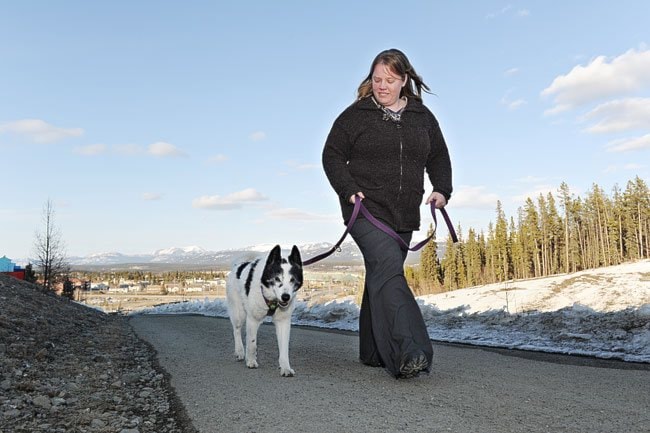A veteran wildlife biologist spoke to a small crowd last night in Whitehorse about how to reduce urban conflicts between humans and bears.
Lori Homstol, a human-bear conflict specialist from the Wind River Bear Institute of Canada, was brought up from B.C. to speak by WildWise Yukon. She was accompanied by her 15-year-old Karelian bear dog, Sisko.
WildWise is a non-profit society that was formed in late 2012, in the wake of two consecutive summers of frequent human-bear encounters in and around Whitehorse. In the summer of 2012 alone, 94 bear conflicts in the Whitehorse area were reported to Environment Yukon. Seventeen bears had to be relocated, and 21 bears were killed - five in self-defence, and 16 because they had become habituated to human food and so were a potential safety risk.
Homstol is based near Pemberton, and works primarily with black bears in Whistler and grizzlies in Kananaskis, Alberta. She told the crowd that Whistler has an astonishing one bear per square kilometre. “It’s hugely productive habitat,” she said, “supplemented by garbage and bird feeders.”
She outlined the various factors involved in reducing human-bear conflict: reducing available garbage and other potential food sources, educating people and enforcing relevant restrictions and bylaws, and teaching bears to steer clear.
She noted dryly that modifying human behaviour should be easier than modifying bear behaviour, but that this isn’t always the case.
At the Wind River institute, Homstol and Sisko use a technique known as “bear shepherding” to teach bears to avoid humans. “The goal is not to make bears afraid of people. We don’t want scared bears,” she said, since a frightened animal can quickly become a threat. “We teach wariness.”
Karelian bear dogs were originally bred as hunting dogs in Russia and Finland. Working in small groups, they were trained to seek out elk, moose, bear or other prey, and to herd them the way a sheepdog might with sheep. Now, Sisko and his colleagues are taught to seek out bears and bear signs, and to alert their handlers - field workers like Homstol - to their presence.
That allows the Wind River teams to, for instance, check a popular hiking trail to see if it’s bear-free, and to identify problem bears that need to be discouraged from staying in the area. Then, their deterrent tools include yelling and using a thumper gun to fire rubber bullets and beanbag rounds.
“We want to teach them that human areas are not safe places to be, but we want to do that without causing actual harm to them,” Homstol told the News.
But those techniques rarely work if a bear is already hooked on garbage, and so waste management is crucial. “If they’re not into garbage, it’s easier to use non-lethal methods,” Homstol explained. “They don’t unlearn what garbage is.”
That means the critical factor in reducing bear trouble each spring is for residents to commit to proper management of garbage and other urban food sources. According to Homstol, “education is always the first step.”
